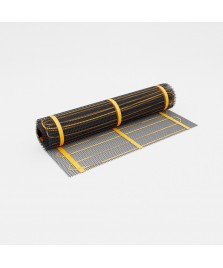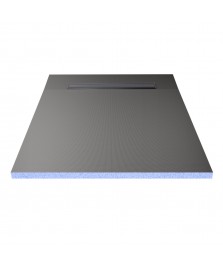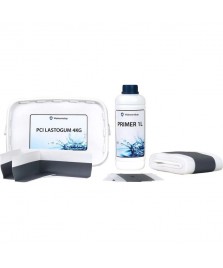- today
- label Wet Room Kits
- favorite 0 likes
- remove_red_eye 1774 views

Wet rooms boast sleek design and practical functionality. But even the most stunning wet room can fall victim to a common enemy: humidity. High humidity in your wet room can lead to a number of problems, including mould and moisture damage.
We explore why humidity is a concern, how it can impact your wet room, and, most importantly, how to tackle it effectively.
Why Humidity Is a Problem in Wetrooms
Humidity refers to the amount of moisture in the air. While a certain level of moisture is normal in bathrooms and wetrooms, excess levels can cause several problems, including:
Mould Growth
Mould is a type of fungus that spreads through tiny spores in the air. It loves damp, humid places to grow. Preventing humidity reduces the chance of mould taking hold in grout, sealants, walls, and other wet room surfaces. Mould can damage these surfaces, decrease air quality, and pose health issues if inhaled.
Dripping Water
When warm, moist air meets cooler surfaces, the moisture condenses. This water can drip down walls or pool on windowsills, causing damage over time. It also feels unpleasant in your wet room.
Musty Smells and Respiratory Issues
Stagnant, humid air often develops an unpleasant, musty odour. High humidity also causes sinus issues and can worsen allergies and asthma.
Tell-Tale Signs of a Humid Wetroom
-
Condensation on walls, tiles, and windows, even after a short shower
-
A musty odour in the air
-
Visible mould on grout, sealant, or silicone
-
Damp patches on walls or ceilings
By minimising excess humidity in your bathroom, you can prevent these problems and keep your wet room space fresh, healthy, and looking its best.
Strategies to Reduce Humidity in the Bathroom
Fortunately, there are many easy ways to reduce and control the levels of moisture in the bathroom.
1. Boost Ventilation with Extractor Fans
This is your first line of defence against humidity issues. Ensure your wet room has a properly functioning extractor fan. Ideally, the fan should be powerful enough to extract all the moist air generated in the wet room.
For an average-sized wet room, look for fans with a minimum extraction rate of 15 litres per second (l/s). Turn the fan on before stepping into the shower and leave it running for at least half an hour afterwards.
Additional Tip
Look for an extractor fan with a timer that can be set to turn off automatically after a set period.
2. Keep the Door and Windows Open
After showering, leave the bathroom door open for a while. This allows the humid air to escape into adjacent rooms in your house. Just be sure the adjoining rooms have good airflow.
If your wet room has a window, make the most of it! Fresh air is a powerful tool against dampness. Whenever possible, open the window during and after every shower to allow natural ventilation. This helps expel the damp air and keeps your wet room cool and dry.
Additional Tip
If your wet room does have a window, consider installing a window vent, which allows for passive ventilation.
3. Keep Your Bathroom Cool and Dry
Hot showers are lovely, but they also create a very humid room. In summer and on warmer days, opt for a lukewarm shower instead. Keeping your wet room generally cool helps reduce the level of moisture the air can hold. Also consider turning down the radiator in your wet room, especially after showering.
Additional Tip
Take shorter showers whenever possible. While everyone loves a long, luxurious soak, shortening its duration can significantly reduce humidity in your bathroom.
4. Wipe Down Surfaces with a Squeegee
Once you've showered, use a squeegee to remove excess water from the walls, tiles, and glass. This simple step helps prevent water droplets from accumulating and evaporating into the air, contributing to a humid environment.
Additional Tip
Don't forget the floor. Use a cloth to wipe up any puddles and mop the floor after showering to prevent moisture from lingering.
5. Consider a Dehumidifier to Remove Humidity
When ventilation alone isn't enough, a dehumidifier can be a valuable tool. A dehumidifier is a portable appliance that draws moisture out of the air, effectively reducing the humidity. This can be particularly helpful in poorly ventilated wet rooms or during colder months when opening windows isn't practical.
Additional Tip
Certain plants like Boston ferns and peace lilies are nature’s dehumidifiers. These plants thrive in humid places and actively absorb moisture from the air. However, when choosing plants, ensure they are non-toxic to children and animals in case of accidental ingestion.
6. Use Absorbent Materials
Incorporate moisture-wicking materials like grout with added silicone, tile backer boards, and bathroom ceiling panels or wall boards designed to capture steam.
Additional Tip
You can also absorb excess moisture using products like silica gel or calcium chloride, which come in convenient sachets or tablets.
How to Prevent Mould Growth in Wetrooms and Bathrooms
While the above solutions will help manage moisture in your wet room, keeping mould at bay requires a multi-pronged approach.
1. Address Water Vapour and Condensation
Condensation is a key indicator of increased humidity levels. If you persistently notice it on walls or windows, it's essential to address the underlying cause. This could be due to poor insulation or inadequate airflow. Consider insulating your wet room walls, especially if they are external, to prevent cold surfaces that encourage condensation.
2. Choose Your Materials Wisely
Using the correct materials is essential when constructing or renovating your wet room. Opt for tiles with a low water absorption rate and ensure proper grouting with a mould-resistant sealant. Make sure you use high-quality supplies, including tanking kits, wet room shower trays, drains, and enclosures, as they work to create a watertight and mould-resistant environment.
3. Clean Regularly
Regular cleaning and maintenance go a long way in eliminating the build-up of mould. Pay close attention to areas where moisture tends to collect, like shower enclosures, grouting, and around shower trays. Use appropriate cleaning products to remove any soap scum, limescale, or mildew build-up that might provide a breeding ground for mould spores.
Wetroomstop: Quality Supplies to Combat Humid Wetrooms
By following these simple steps, you can effectively lower the humidity in your wet room and enjoy a healthier, more comfortable bathing experience.
Visit Wetroomstop for all the supplies you need to upgrade your wet room. We supply waterproofing membranes and shower screens to help prevent leaks. Our shower trays and linear drains ensure proper water drainage, while our bathroom sealants resist mould and mildew growth.
Browse our extensive selection today or get in touch with our team to find the perfect products for a healthy, stylish, and functional wet room.














